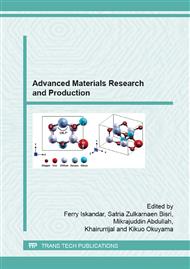[1]
E. Medvedovski, Alumina–mullite ceramics for structural applications, Ceram Int. 32 (2006) 369–375.
DOI: 10.1016/j.ceramint.2005.04.001
Google Scholar
[2]
Y.K. Paek, E. Suvaci and G.L. Messing, Preparation and Fracture Behavior of Alumina Platelet Reinforced Alumina-Monazite Composites, Material Transcactions, 43 (2002) 3262 – 3265.
DOI: 10.2320/matertrans.43.3262
Google Scholar
[3]
Ting, et al., Sintering of Alumina with Titania as Sintering Additive, ICCBT (2008) p.197 – 202.
Google Scholar
[4]
D.S. Horn and G.L. Messing, Anisotropic grain growth in TiO2-doped alumina, Mater Sci Eng A. 195 (1995)169 – 178.
DOI: 10.1016/0921-5093(94)06516-0
Google Scholar
[5]
J.S. Forrester, et al., Effect of Mechanical Milling on the Sintering Behaviour of Alumina, J. Aust. Ceram. Soc. 44 (2008) 47-52.
Google Scholar
[6]
P. Rao, M. Iwasa and I. Kondoh, Properties of low-temperature-sintered high purity α-alumina ceramics, J Mater Sci Lett 19 (2000) 543 – 545.
Google Scholar
[7]
J. Mollá, R. Moreno and A. Ibarra, Effect of Mg doping on dielectric properties of alumina, J Appl Phys 80, 1028, (1996).
DOI: 10.1063/1.362836
Google Scholar
[8]
Kurmidi, Sintesis Keramik Al2TiO5 Densitas Tinggi dengan Aditif MgO, Undergraduate Thesis, Institut Teknologi Sepuluh Nopember, Surabaya, Indonesia, (2011).
DOI: 10.15676/ijeei.2015.7.3.11
Google Scholar
[9]
Santiani, Pengaruh Penambahan MgO pada Sifat Fisik dan Mekanik Keramik β – Al2O3, Undergraduate Thesis, Institut Pertanian Bogor, Bogor, Indonesia , (2002).
DOI: 10.6066/jtip.2016.27.2.165
Google Scholar
[10]
M.W. Barsoum, Fundamentals of Ceramics, Institute of Physics Publishing Bristol and Philadelphia, USA, (1997).
Google Scholar
[11]
T. Ikeagami and K. Kotani, Some Roles of MgO and TiO2 in Densification of a Sinterable Alumina, J. Am. Ceram. Soc, 70 (12) (1987), 885 – 890.
DOI: 10.1111/j.1151-2916.1987.tb04911.x
Google Scholar
[12]
A. Johan, Karakterisasi Sifat Fisik dan Mekanik Bahan Refraktori α-Al2O3 Pengaruh Penambahan TiO2, Jurnal Penelitian Sains Vol. 12, Nomer 2(B) 12207, (2009).
Google Scholar
[13]
C.J. Wang, C.Y. Huang and Y.C. Wu, Two-step sintering of fine alumina-zirconia ceramics, Ceram int, (2008).
Google Scholar
[14]
S. Lio, H. Yamamoto, and T. Mitsuoka, Microstructure control of alumina ceramics, 24th Annual conference on Composites, Advanced Ceramics, Materials, Structures-B: Ceramics Engineering and Science Proceedings, 21(4), (2009).
DOI: 10.1002/9780470294635.ch55
Google Scholar
[15]
A. Kebbede, G.L. Messing, and A.H. Carim, Grain Boundaries in Titania-Doped α-Alumina with Anisotropic Microstructure, J. Am. Ceram. Soc, 80 (1997), 2814 – 20.
DOI: 10.1111/j.1151-2916.1997.tb03198.x
Google Scholar
[16]
W. Jo, D.Y. Kim and N.M. Hwang, Effect of Interface Structure on the Microstructural Evolution of Ceramics, J Am Ceram Soc. 89 (2006) 2369 – 2380.
Google Scholar


